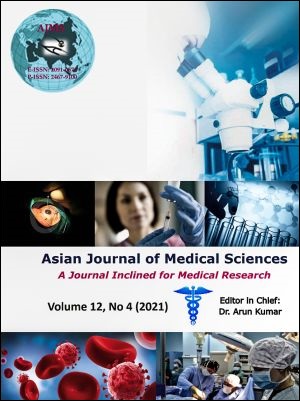Hysteroscopy is Gold standard in Uterine evaluation for Infertility, but HSG still has a place
Keywords:
Hysteroscopy, USG, Infertility, Uterine Cavity, IVFAbstract
Background: Uterine abnormalities, congenital or acquired are implicated as causal factor in 10%-15% of infertile couplesreporting for treatment. Hysteroscopy, hysterosalpingography (HSG), saline-infusion-sonography and USG are available for evaluation of uterine cavity. HSG helps in initial evaluation of a sub-fertile woman, but hysteroscopy is gold standardas itallows direct visualisation ofintrauterine pathology and treatment in same-setting, if required.
Aims and Objective: To describe hysteroscopic findings of infertile patients and compare the observations with their respective HSG findings.
Materials and Methods: It’s a prospective analysis of 105 women with infertility who attendedtertiary-care hospital during 18 monthsfulfilling pre-defined inclusion and exclusion criteria. All cases were evaluated with both HSG and hysteroscopy, observations were recorded and co-related with each other.
Results: Among 105 cases, maximum (76.19%) were 25-35 years of age. The primary infertility accounted for 68.57% cases.Abnormal HSG findings observed in 19 cases (20%), most common being filling-defect.Hysteroscopy detected abnormalities in 39 cases (37.14%), commonest being endometrial polyp. Out of 39 cases of abnormal uterine cavity detected on hysteroscopy only 19 were picked-up by HSG, rest 20 cases failed to be identified. The strength of agreement between hysteroscopy and HSG calculated is moderate (Kappa=0.505).
Conclusion: As HSG hadlow false positivity (03%), high positive-predictive-value (90.48%) and negative-predictive-value (76.19%) and high specificity (96.96%) it is still considered as a first-choice screening method of uterine cavity. However, high false-negative-value (51.28%)of HSG makes Hysteroscopy a better diagnostic test. HSG couldn’t differentiate endometrial polyp, adhesions and submucous fibroid, shown them as filling defect only.
Downloads
Downloads
Published
How to Cite
Issue
Section
License
Authors who publish with this journal agree to the following terms:
- The journal holds copyright and publishes the work under a Creative Commons CC-BY-NC license that permits use, distribution and reprduction in any medium, provided the original work is properly cited and is not used for commercial purposes. The journal should be recognised as the original publisher of this work.
- Authors are able to enter into separate, additional contractual arrangements for the non-exclusive distribution of the journal's published version of the work (e.g., post it to an institutional repository or publish it in a book), with an acknowledgement of its initial publication in this journal.
- Authors are permitted and encouraged to post their work online (e.g., in institutional repositories or on their website) prior to and during the submission process, as it can lead to productive exchanges, as well as earlier and greater citation of published work (See The Effect of Open Access).




